2019 Triumph Street Triple R Low Ride Reviews
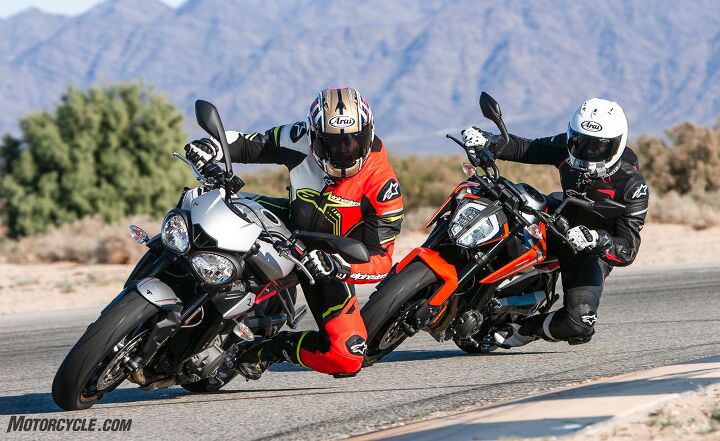
You'll meet a theme if you scroll back the last decade or so on MO : we have a thing for the Triumph Street Triple. Subsequently numerous rides and shootouts each time it gets updated, it's safe to say we love that little 675cc three-cylinder. The sound it makes is outrageously absurd, the power information technology delivers is fun without being overwhelming, and the overall package is an absolute nail. Yeah, the looks are kinda polarizing, only none of that matters once yous twist the grip.
Become the Flash Player to see this player.
Then, lo-and-behold, Triumph one-upped itself and upgraded the Street Triple at the stop of 2017 every bit a 2018 model, giving it a pregnant bump in displacement: up to 765cc – much to the grins of dyslexics everywhere. Of course, the magic of three cylinders didn't go anywhere, and the new bike was in one case again a hit amongst us all. Tom "Biceps" Roderick seriously considered ownership one when he walked out the proverbial MO door on his way to self-employment. Meanwhile, we all liked information technology enough to name it Motorcycle.com's All-time Standard Motorbike of 2018 . And past "it" I'm talking virtually Triumph's top-of-the-range RS version of the Street Triple. Contenders for the Streetie's crown have come and gone, and while some have washed improve than others at swaying our opinion, at the cease of the mean solar day our hearts take always gravitated back to the Triumph.
KTM's response? "Challenge accustomed."
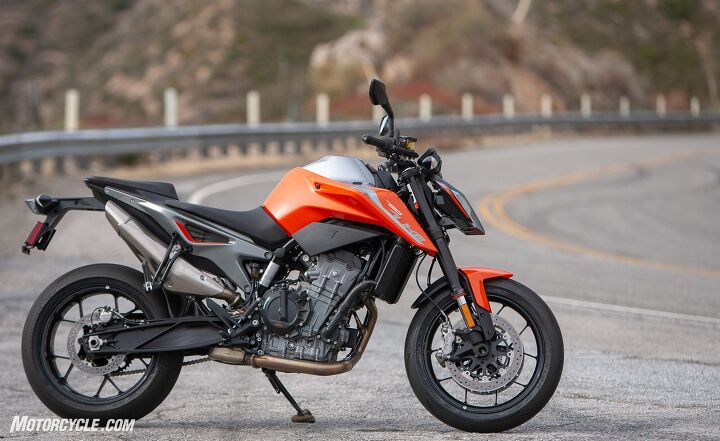
"I see your Street Triple R, and I raise you this." -KTM
Okay, we seriously doubt this was actually said inside some KTM lath meeting (although information technology'd exist not bad if information technology were), but when information technology comes to benchmarking an existing model for KTM'southward new 799cc parallel-Twin, Team Orange couldn't have picked a ameliorate target. Of course, we all know the result: the 790 Duke. Our European friends got to taste the Orangish kool-assistance a year before we did, just when Evans came dorsum from his 790 Duke First Ride he really loved it – as in, he was thinking of means to purchase ane without pissing off his wife. Naturally, our response was to put the KTM head-to-head with the Triumph to see if our favorite piddling Triple could hold off nevertheless another challenger. If you need detailed overviews of each bicycle, click on the links above for a breakup.
Keeping things Apples to Apples
Naturally, we do our best to keep comparisons equally off-white as possible, and the basis of this starts with price. The 790 Duke only comes in one flavor with pricing fix at $x,499. With that, yous get a potent 799cc parallel-Twin – which, as you should know by now, is a first for KTM – pumping out 98.0 hp and 60.2 lb-ft to the rear wheel on the MotoGP Werks dyno. Accompanying the Twin is an electronics suite featuring adjustable (and switchable) traction control, ABS, power modes, and best of all, a quickshifter in both directions. Brakes are twin 300mm discs with J.Juan radial-mount 4-pot calipers in the front, 240mm single disc and one-pot J.Juan caliper in the back. WP handles suspension duties (pun not intended), but cheaps out a bit offering a non-adjustable 43mm fork and a daze with only preload settings available.
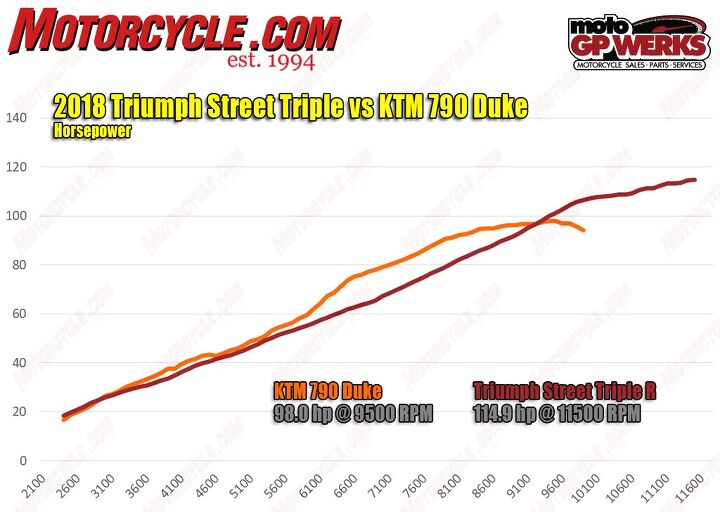
If you wait strictly at the numbers, the Triumph wins the horsepower war. Wait closer and you'll run across information technology's only subsequently the KTM signs off that the Street Triple gets its advantage.
The Street Triple, however, comes in a variety of flavors, from the $9,950 S model on upward to the $12,550 RS. While the latter gets all the bells and whistles like a quickshifter (merely for upshifts), five ride modes, Brembo M50 calipers, Öhlins stupor, and the most ability in the range – a claimed 121 hp and 57 lb-ft – the toll moves it rather far away from the KTM, especially considering the Triumph too comes in an R version starting at $11,250 – much more than in line with the 790. For that price, the R gets Brembo M4.32 calipers, Showa Big Piston fork and adjustable shock, four ride modes (no Rails mode), full TFT instrumentation, and slightly less ability than the RS – ours put down 114.9 hp and 56.seven lb-ft to the wheel, according to the MotoGP Werks dyno.
However, things aren't always as perfect every bit they seem, since nosotros were sent the R model in the Matt Aluminum Silver colour, adding $250 extra, for a total of $xi,500. A whole thousand bucks more than than the KTM. To confuse matters that much more, the base of operations Street Triple South version starts at $ix,950 and moves up to $10,200. While that may be the closest from a cost perspective, the S model is slightly detuned from the R (which is already a little downwards to the RS), only gets two riding modes, lower-spec Showa suspension, and basic pivot-slide two-piston Nissin brakes. Neither the R or S gets a quickshifter, but going on toll and which features most closely line upwardly, nosotros opted for the Street Triple R to confront the 790 Duke.
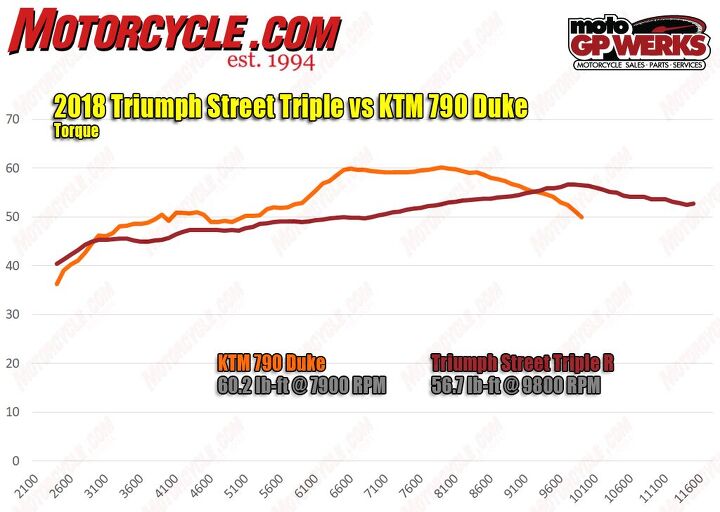
The picture looks even worse for the Triumph in the torque department, where the KTM has its number. But look at that reward in the midrange – although the Triumph's fueling does look much cleaner.
The process is fairly elementary from hither: we flog them on the street, then rinse and echo at the runway, joining our friends at Rickdiculous Racing for a twenty-four hour period at Chuckwalla. Keeping with the apples-to-apples theme, we spooned each bike with Dunlop's Q4 tire . We did this for a few reasons. First, the Q4 is a track-focused tire for the road rider, meaning it can handle street riding just fine, but information technology also heats up apace for track apply without the demand for warmers – perfect for the states lazy MO rons who don't want to bother with slapping blankets on tires after each session. Second, and mayhap more importantly, the standard tires on our exam Triumph were already squared off in the center from a previous user. That would have impacted handling severely and unfairly against the ST765.
Considering my time aboard the Kramer GP2 Prototype , powered by the aforementioned 799cc Twin as the KTM, I was anxious to run across how the 790 Knuckles would perform. Joining me on this flog-a-thon is none other than "Biceps" Roderick, coaxed out of semi-retirement by the call of a wailing Triple and a burbling Twin (and the offer of a free breakfast). Simply since he was on the verge of actually ownership a Street Triple, Tom was the perfect candidate.
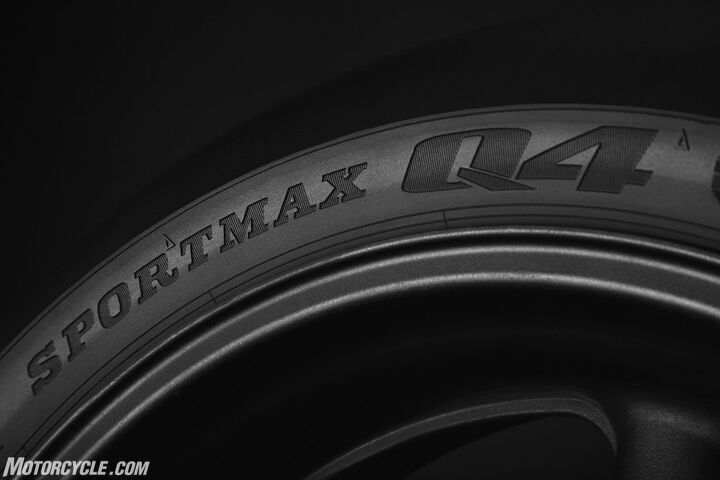
Nosotros opted to run the Dunlop Q4 tires on both bikes for a few reasons, but mainly considering we didn't want to use tire warmers at the racetrack.
This is why nosotros do this
Looking at the specs (and considering our by experience), on paper the Triumph appeared to exist amend of the two. With 3 cylinders, more power, and simply a nine-pound weight difference on the official MO scales (420 lbs vs. 411 for the KTM), both Tom and I had a hard fourth dimension imagining the Triumph losing. Out on the route, the Streetie exhibited all of its lovable character, too. The three-cylinder wail is as exhilarant as always, and now that information technology has more displacement, the extra shove when you twist your wrist adds to the excitement factor. Not having a quickshifter was a chip of a drag, but that'southward a starting time-world problem if ever there were 1. The Streetie shifts only fine if you know what yous're doing, and the slipper clutch does a great job of keeping the rear in check if you don't. Adjustable levers and an informative TFT display, including gear indicator, are also a overnice touch.
If the specs and the dyno numbers were all we needed to determine these tests, then our job would be incredibly easy (and boring). Sometimes though, the magic can't be plant on a piece of paper. This is the beauty of the KTM 790 Duke. Despite what the numbers say, both Tom and I cruel for the 790 instantly. KTM dubs the bigger 1290 Super Duke R "The Beast" and this, the 790 Knuckles, "The Scalpel" – and later on riding it, the proper noun definitely fits. The smaller Duke takes the attitude of the big, burly 1290 and refines it to a precision-like quality with the 790.
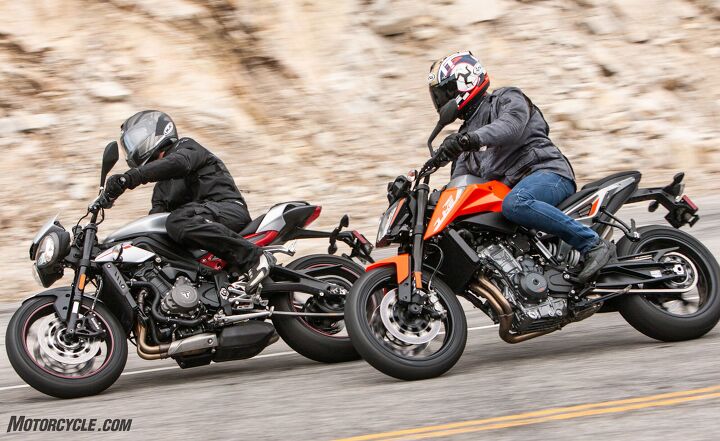
Despite having one less cylinder than the Triumph, Tom was convinced this is "probably one of the all-time parallel-twin engines always! The Trumpet may make more meridian horsepower, simply look for yourself at the dyno chart and see how the KTM'south Twin romps the Triumph's Triple from 3,100 rpm to 9,100 rpm in horsepower production, while also producing significantly more torque through the same rev range. And the dyno data can exist felt in the real world whether on the street or at the track."
This is the secret sauce behind the KTM. While the Triumph makes more ability, it'due south but later the KTM hits redline that the 765 Triple shines, meaning you accept to wind it up to proceed hunt. At Chuckwalla this wasn't much of an result, since you naturally keep engines singing at the track – and in fact the Triumph hands kept the KTM in its grit when it came to outright speed. Simply when you're cruising the street or even playing in the canyons, the broad spread of power from the Knuckles is easier to tap into.
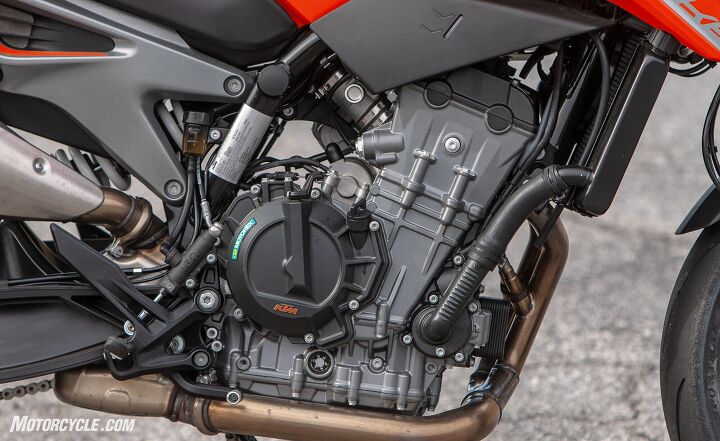
The heart of the KTM 790 Duke is this 799cc parallel-Twin engine that punches way higher up its weight.
Of class, since the KTM has a smaller rev window compared to the Triumph, you as well have to shift more. Non a problem, since the Duke not only has a quickshifter, but information technology works for both up- and down-shifts – swell for $10,5K. That said, the QS isn't the slickest organization in the world. Downshifts are a little clunky at times, and if I really wanted to go from 6th to tertiary quickly I'd resort to using the clutch. Still, it's nice to accept.
"As impressive to its power production is the KTM'south treatment," Tom says. "Eager to get leaned into a corner, the KTM holds its trajectory and absorbs road imperfections surprisingly well for a bike with non-adjustable suspension units." It'due south true. Despite its bones suspension $.25, nosotros never plant ourselves eagerly wishing to adjust settings at either end on the KTM, even at the track. Could they be improve? Sure, slightly stiffer springs and/or increased damping wouldn't hurt.
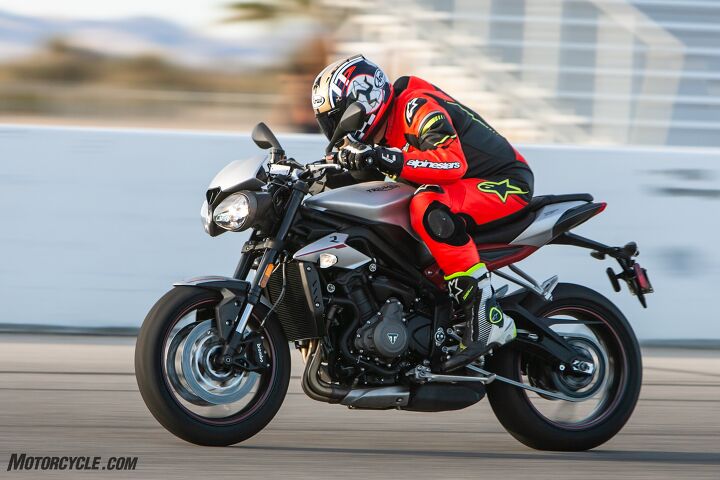
When given room to stretch its legs, the KTM only gets smaller in the Triumph's mirrors.
The biggest surprise by far is how each motorcycle carries its weight. As T-Rod explains, "What doesn't interpret from paper to real world is the KTM's seemingly modest ix-pound weight advantage. I'm withal scratching my head at how KTM managed to make the 790 Duke feel 50 pounds lighter than the Street Triple. Whatsoever magic combination of CoG, rake, trail and wheelbase numbers works so well I just can't believe it's non butter."
Equally if this test didn't bring us a few surprises already, what continually left us floored was how much lighter the 790 feels. It's worth proverb information technology again – the KTM is only nine pounds lighter than the Triumph – but whether on the street or the rails, hustling each bike from side to side was dramatically different. The Street Triple feels slow and lethargic (words nosotros'd never otherwise apply to describe the ST) compared to the quickness and agility of the 790 Knuckles. Information technology'southward otherworldly.
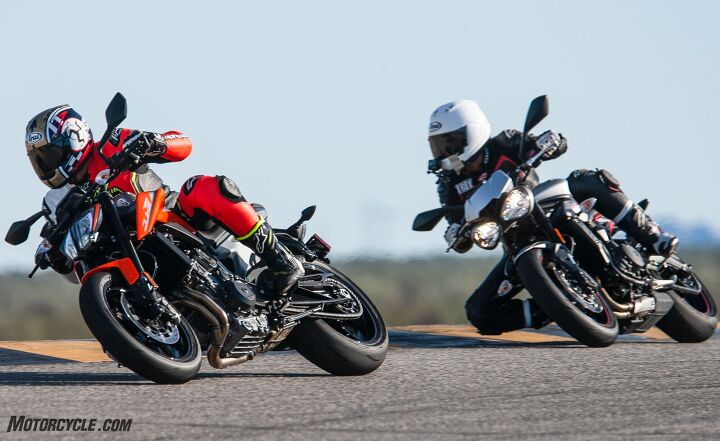
Screw what the scales say. You lot really need to ride the two back-to-dorsum to understand how much lighter the KTM feels compared to the Triumph.
On the electronics front, both are equipped with TC and ABS. At the rail, both ABS systems intervene earlier than prefered, the Triumph specially and so, leading me to shut them off. The Duke does come with a Supermoto ABS setting, letting you lock the rear wheel to your heart's content. That said, Tom and I are split near which brakes we prefer. Personally, I lean towards the feel and power of the Triumph's Brembos while Tom's on the KTM'south side. The TC nod also goes to the KTM, as it'due south adaptable to dissimilar levels, and performs remarkably well at putting the power down without too much distraction to the passenger. In one case skid is noticed on the Street Triple R, power is cutting dramatically. And there'due south just on or off, no selecting of different levels.
Turning our attention abroad from flogging and onto slogging – as in, coincidental riding – things look a trivial better for the Triumph. First, "the Triumph has a much cushier seat compared to the KTM's apartment, densely-cushioned pad," says Tom. "But the extra legroom on the Duke and more upright riding position kept me happier during state highway riding." Personally, I appreciated the KTM's actress legroom, just the upright seating position left me feeling like a canvass on the highway. Without whatever air current protection, I preferred the Triumph's slight forrad lean to help commencement the windblast.
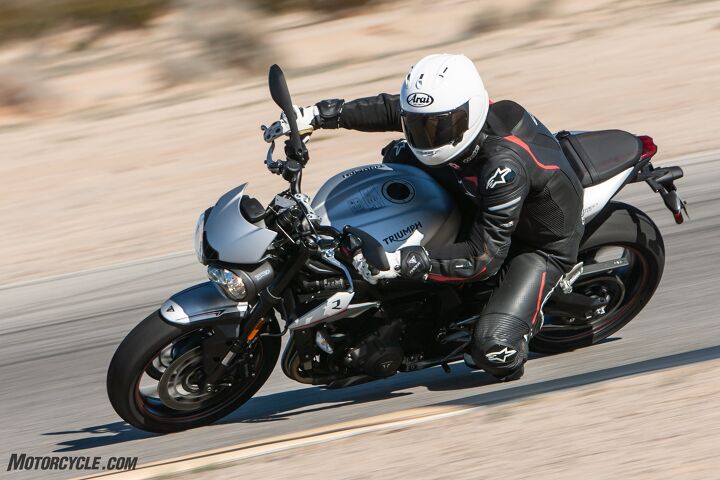
If the KTM 790 Duke didn't exist, we'd continue to be singing the Triumph'south praises. In fact, if nosotros had the RS to play with our opinions might be different.
Need nosotros say more?
This is one of those rare times when we don't need the MO scorecard to pick a winner. If you've read this far it should seem fairly obvious. It's but surprising to u.s. that information technology happened with these bikes. At first, we idea the Triumph had an easy win lined upward for itself. Turns out the reality was entirely different. Allow Tom clarify:
"There'southward actually nil to complain about when it comes to the Triumph. Information technology's notwithstanding the same excellent motorcycle with all qualities we love that catapulted it to the top of MO'due south 2018 Best Standard category. It's only when ridden back-to-back with the Duke that it becomes apparent how much heavier and lethargic the ST3 is compared to the new Duke. All the same, maybe I'd change my tune if information technology were the RS model for $two,000 more.
For the $1k price difference, and considering all the other previously mentioned reasons, information technology'southward like shooting fish in a barrel to chose the KTM over the Triumph. With the money saved a person tin then go about upgrading the KTM's merely real flaw (if you want to call it that) — it's non-adjustable suspension components."
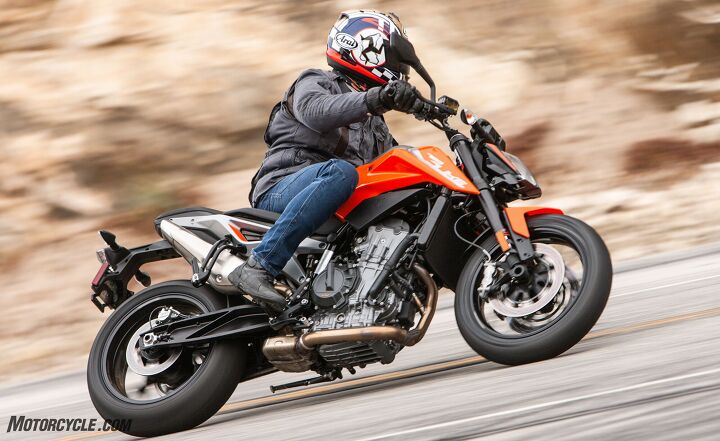
We accept a new trounce in the middleweight category. And it'south Austrian.
| 2019 KTM 790 Knuckles vs. Triumph Street Triple R Scorecard | ||
|---|---|---|
| KTM 790 Duke | Triumph Street Triple R | |
| Price | 100% | 91.7% |
| Weight | 100% | 97.9% |
| lb/hp | 87.one% | 100% |
| lb/lb-ft | 100% | 92.2% |
| Total Objective Scores | 97.ix% | 95.2% |
| Engine | 95.6% | 95.0% |
| Manual/Clutch | 90.0% | 85.0% |
| Handling | 92.5% | 83.8% |
| Brakes | 86.three% | 87.5% |
| Suspension | 77.5% | 88.8% |
| Technologies | xc.0% | 82.5% |
| Instruments | ninety.0% | 87.5% |
| Ergonomics/Comfort | 90.0% | 86.3% |
| Quality, Fit & Cease | 88.8% | 92.5% |
| Cool Factor | 88.8% | 88.8% |
| Grin Factor | 91.3% | 87.5% |
| Tom's Subjective Scores | 89.viii% | 88.5% |
| Troy'southward Subjective Scores | 89.vi% | 88.1% |
| Overall Score | 91.3% | 89.7% |
| Specifications | KTM 790 Duke | Triumph Street Triple R |
|---|---|---|
| MSRP | $ten,499 | $11,450 (as tested) |
| Engine Blazon | 799cc liquid-cooled Parallel-Twin | 765cc liquid-cooled, in-line 3-cylinder |
| Bore and Stroke | 88.0mm x 65.7mm | 77.nine x 53.4mm |
| Fuel System | DKK Dell'Orto, 46 mm Throttle Body | Multipoint sequential electronic fuel injection with SAI. Electronic throttle control |
| Compression Ratio | 12.7:i | 12.65:1 |
| Horsepower (measured) | 98.0 @ 9500 rpm | 114.ix @ eleven,500 rpm |
| Torque (measured) | 60.two lb-ft @ 7900 rpm | 56.seven lb-ft @ 9800 rpm |
| Valve Train | DOHC; four valves per cylinder | DOHC; four valves per cylinder |
| Transmission | vi-speed | 6-speed |
| Last Bulldoze | Concatenation | Chain |
| Front end Suspension | WP inverted 43 mm fork, not-adjustable, 5.5 in. travel | Showa 41 mm upside downward carve up office big piston forks (SF-BPF), 115 mm front wheel travel. Adjustable compression damping, rebound damping and adaptable preload |
| Rear Suspension | WP Monoshock, preload adaptable, v.9 in. travel | Showa piggyback reservoir monoshock, 134 mm rear wheel travel. Adaptable spring preload (lock-rings), compression damping and rebound damping. |
| Front Brake | Dual 300 mm discs, radial-mount iv-piston J Juan calipers, ABS | Twin 310 mm floating discs, Brembo M4.32 4-piston radial monobloc calipers, switchable ABS |
| Rear Brake | Single 240 mm disc, unmarried-piston J Juan caliper, ABS | Single 220 mm fixed disc, Brembo single piston sliding caliper, switchable ABS |
| Front end Tire | 120/seventy-17 | 120/70-17 |
| Rear Tire | 180/55-17 | 180/55-17 |
| Rake/Trail | 24.0°/3.8 in. (96.5mm) | 23.9°/3.94 in. (100.0mm) |
| Wheelbase | 58.0 in. | 55.5 in. |
| Seat Height | 32.v in. | 32.5 in. |
| Curb Weight (MO Measured) | 411 lbs. | 420 lbs. |
| Fuel Capacity | three.7 gal. | 4.6 gal. |
Source: https://www.motorcycle.com/shoot-outs/a-disruption-in-the-force-ktm-790-duke-vs-triumph-street-triple-r
Post a Comment for "2019 Triumph Street Triple R Low Ride Reviews"